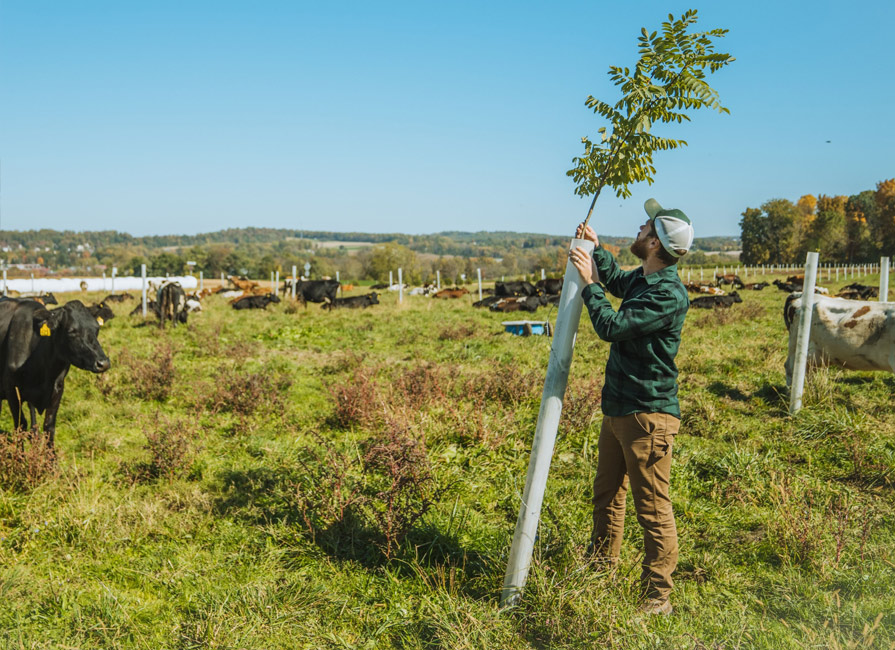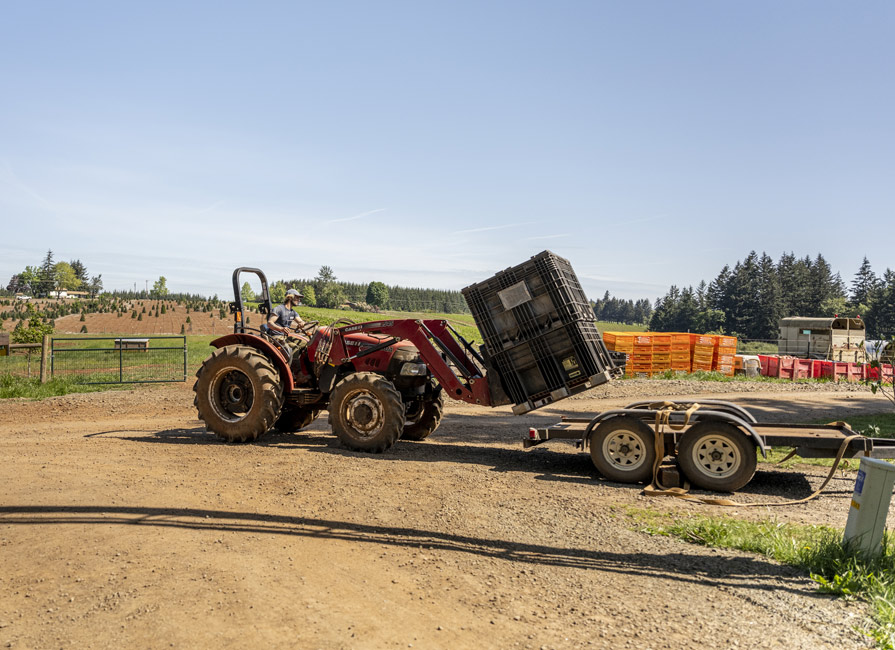One of the key attractions of our Certified Regenerative by AGW program is its practical…

Branching Out
As someone who spends a lot of time talking with farmers about planting trees, there’s a certain phrase I’ve heard more times than I can count. “Why in the world would someone do that? My Grandad spent years clearing the woods so we can farm.”
Busting tree myths
If you’re reading a grazing publication, I’ll assume you’re a bit more open to new ideas than the typical farmer. If you’ve converted to pastured livestock, chances are your neighbors already think you’re a bit loony. But to plant trees in that pasture?! You’d be nuts!
If you have some hesitations about planting trees (not least because several ancestors would roll over in their graves), that’s normal. But here’s the deal: these are not your grandpa’s trees.
If the trees your grandpa cleared were a rusty jalopy sitting out back with a broken axle, what you can now plant is more akin to a shiny F-150. We’re not talking planting random trees at random places and crossing our fingers that they’ll survive. We’re talking planting the right species with the right genetics in the right places in a way that will complement your farm.
Two paths
When thinking about what trees can do for a farm, I like to think about two paths that people can go down.
First, we can choose to plant trees that will add new enterprises to the farm. Here we’re talking about growing timber, fruits or nuts. Planting pecans or English walnuts for their nuts, apples for cider, or black walnuts and black locust for timber. Each one will allow you to diversify the farm operation and develop new income streams. The second is to choose trees that will strengthen your current livestock operation. Whether you raise dairy or beef or sheep or hog or poultry or alpacas, you can plant trees that will make what you already do more profitable and resilient. We do this by planting trees that will provide the shade, fodder, windbreak, and nitrogen that will keep your livestock healthier, more comfortable, and better fed than could be done with pasture alone.
Of course, these two paths don’t have to be mutually exclusive. You can focus on adding trees to serve your livestock while also planting a patch of heartnuts or chestnuts. Just keep in mind that planting fruit and nut trees across the whole farm for commercial yield is a whole other game than planting for home use alone.
The next level
What is certain is this. When adding trees to pasture, the low-hanging fruit is not fruit (or nuts). The easiest place to start is to hone in on those trees that will take your grazing management to the next level.
Plant persimmons to drop high-energy fruits packed with vitamins in the fall. Plant black locust to fix nitrogen while letting dappled shade cool your livestock and forages. Best yet, plant honey locust for a complete package of nitrogen fixation, light canopy, and calorie-packed pods dropped from October through January.
If you already have your hands full and don’t foresee more folks joining the farm business, this is a great place to stop reading. However, if junior is coming up and wants a role on the farm, or you want the farm to support multiple families, adding trees for saleable crops is vertical integration of a business in the most literal sense.
You’ll need to go into it wide-eyed about the investments you’ll need to make in order to harvest, process and market your wares, as well as an awareness of food safety regulations. But, thankfully, there’s a growing body of information to help you make those decisions. If you’re interested, I would suggest reading Perennial Pathways: Planting Tree Crops by the Savanna Institute for starters.
Planting a legacy
Your grandpa never really had the opportunity to plant trees this way. The information, support, genetics, and resources were just so much tougher to come by. If he had pulled it off somehow, you might now have a farm with towering honey locusts feeding the herd through the winter, hybrid oaks for fattening hogs, and apples for pressing into cider. Today, the resources, support and information are all available, ready for you to take grazing to the level. What are you waiting for?
Springing up
Most folks come to silvopasture with the simple goal of shade for their livestock. That was certainly the case for Dwight Stoltzfoos of Springwood Dairy in Pennsylvania.
As one of the largest grassfed dairies in the state, he has a lot of cows that spend a lot of time outside. And production really drops when they get heat stressed. Even though this is expensive grazing ground, Dwight didn’t see any reason not to plant trees, given that he plans to keep the farm in grass in perpetuity.
We worked with Dwight to develop a planting plan, as well to identify funding to pay for the trees, planting, and care of the trees. We planted about 1,200 trees across 40 acres, with a spacing of 60′ between rows and 20′ between trees in the row, all laid out in a grid for easy accessibility. The trees were a mixture of fast growers for quick shade, such as black locust and poplar, plus long-lived species like honey locust and persimmon as a high-energy feed supplement.
Visit springwoodfarm.com.
FURTHER READING
The Grazier’s Guide to Trees is a comprehensive, step-by-step guide to getting trees established in active pastures, including how to select species to address your needs; how to plant and protect trees in active pastures; how to lay out trees in a way that makes sense for your farm; how to access funding; and the long-term aftercare of trees.
Visit treesforgraziers.com.
Silvopasture is an NRCS-defined “climate-smart” practice (#381). Visit nrcs.usda.gov/conservationbasics/natural-resource-concerns/climate.
Author: Austin Unruh is CEO of Trees for Graziers, a multispecies mix of innovators who work together to make silvopasture possible for those who take the long view. Visit treesforgraziers.com.
Originally published in the Fall 2024 issue of AGW’s Sustainable Farming magazine.


